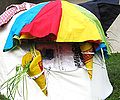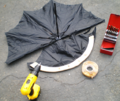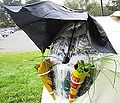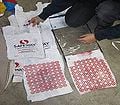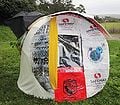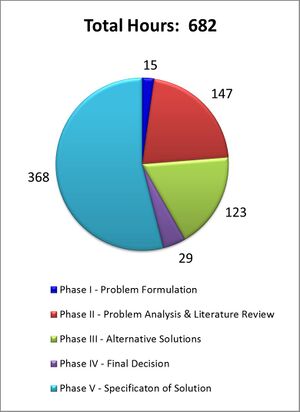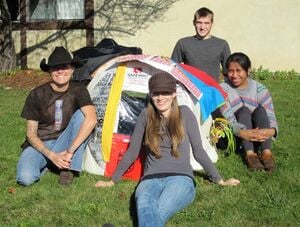
Due to a continual rise in the human population and an uncertain environmental future, the concept of housing and available resources must be rethought. The Flock House, founded by Mary Mattingly, addresses this in a sustainable and artistic manner. As a part of Engineering 215 - Introduction to Design at Cal Poly Humboldt, Team Apple Skins is working with the Flock House to design a comprehensive skin that will complement the structure of the Flock House in a functional and meaningful way.
Background[edit | edit source]
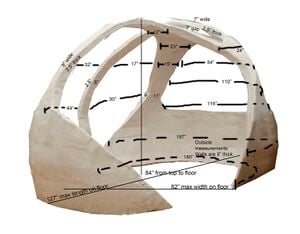
The Flock House is a group of sustainable, mobile, living systems that each house two resident artists. These living systems are designed to educate and inspire people with the dynamic ecological relationships between the Flock House system and New York City. Traveling through the five boroughs of New York City during the summer of 2012, the Flock House hopes to inspire other groups across the country to begin their own interpretations and construction of similar projects.
The schedule for the date and location of the traveling of these units falls within the time frame of May 1st through August 15th of 2012.
Problem Analysis and Criteria[edit | edit source]
The Flock House needs a durable and waterproof skin that is sustainably made.
The objective of Team Apple Skins is to design a comprehensive skin which will complement the structure of the Flock House in order to protect the occupants from inclement weather. The skin will be attached to the preexisting Flock House frame of re-purposed fiberglass. The skin will be made from re-purposed materials that are waterproof and durable. It will be designed such that it may be reproduced via written instructions by the client for their purpose and vision. The skin is also designed to be aesthetically appealing to the public in order to inspire interest and fit with the overall look of the Flock House.
| +Criteria and constrains are needed to determine the success of a solution. Criteria are weighted with 10 being most important and 0 being least important. | ||
| Criteria | Weight | Constraint |
|---|---|---|
| Aesthetically pleasing | 10 | Looks professional and inviting. |
| Translucent | 10 | Windows allow for plenty of sunlight. |
| Inspirational | 8 | Visitor is inspired to investigate system. |
| Changing public perception | 8 | Visitor rethinks previous conventions. |
| Level of environmental impact | 7 | Greater reuse of materials. |
| Repair-ability | 6 | Easily and conveniently repaired. |
| Shape shifting | 5 | Flex when up against walls. |
| Rigidity | 5 | Will not deform when transported. |
| Cost | 5 | $375 or less. |
Description of Final Project[edit | edit source]
The final solution, Poly Pod, is constructed from re-purposed rain gear, umbrellas, plastic grocery bags, and bubble wrap. The solution consists of windows, awnings, planters, a door, and a canopy. Complete instructions for each component are listed in the How to Build Section. The windows are made by ironing bubble wrap between nine clear plastic produce bags. This process creates a flexible yet sturdy panel which can be riveted or screwed into a window frame. Two different awning styles are made using umbrellas, one is retractable and the other is removable. Planters are made by ironing standard grocery bags together and then rolling the resultant panel into a cone while it is still warm and flexible. The door and canopy are also constructed with panels made of grocery bags ironed together. These panels are cut to shape and riveted together.
-
Completed Poly Pod
-
Awning Style A during construction.
-
Awning Style A
-
Awning Style B ready to be constructed.
-
Awning Style B with window
-
Window and components.
-
Awning without window
-
Door under construction.
-
Canopy panels
-
Door with canopy
-
Planter bags.
-
Finished planter
Costs[edit | edit source]
The cost analysis for the Poly Pod is split into design costs, implementation cost, and maintenance cost.
Design Cost[edit | edit source]
Design Cost, totaling at 682, is measured in hours. The following pie chart shows how the total design cost in hours is expended in each phase of the design process.
Implementation Cost[edit | edit source]
| +Implementation Cost shows the costs for all research and design done for the Poly Pod solution. It is divided into the total cost for Team Apple Skins and what a full retail cost would be. | |||||
| Item | Quantity | Retail price per item ($) | Total | Team price per item ($) | Total |
|---|---|---|---|---|---|
| Plastic Produce Bags | 50 | 0.00 | 0.00 | 0.00 | 0.00 |
| Parchment Paper | 1 box | 4.09 | 4.09 | 4.09 | 4.09 |
| Plastic Grocery Bags | 100 | 0.00 | 0.00 | 0.00 | 0.00 |
| Iron | 3 | 25.00 | 75.00 | 0.00 | 0.00 |
| Umbrella | 2 | 10.00 | 20.00 | 0.00 | 0.00 |
| Rain Jacket | 2 | 10.00 | 20.00 | 1.00 | 2.00 |
| Misc. Hardware | 1 | 5.99 | 5.99 | 5.99 | 5.99 |
| Plants | 2 | 3.49 | 6.98 | 3.49 | 6.98 |
| Poncho | 1 | 7.00 | 7.00 | 1.00 | 1.00 |
| Duct Tape | 1 roll | 4.88 | 4.88 | 4.88 | 4.88 |
| Polypropylene Pipe | 100' | 18.99 | 18.99 | 18.99 | 18.99 |
| Weather Stripping | 17' Roll | 6.49 | 6.49 | 0.00 | 0.00 |
| Rivet Gun w/rivets | 1 | 8.81 | 8.81 | 0.00 | 0.00 |
| Total Cost | $178.13 | $43.93 | |||
Maintenance Cost[edit | edit source]
Maintenance cost is measured in hours over a 6-month time frame. It will be necessary to repair awnings and panels which will account for 10 hours apiece. Weatherstripping seams and joints will take 3 hours. Total maintenance cost is calculated to be 23 hours in a 6-month time frame.
Testing Results[edit | edit source]
To transport the Poly Pod from Cal Poly Humboldt to its storage site, Team Apple Skins secured it to the roof of a car. This was done to take advantage of an opportunity to test for how well the Poly Pod would hold up in a windy environment. It held up well with no tearing or deformation at speeds of up to 25mph.
To test for how well the Poly Pod would keep occupants dry in a rainstorm, Team Apple Skins conducted a water experiment. For this experiment, one team member was inside the unit while another used a sprinkler attachment to mimic rainfall. The three different settings utilized were: mist; cone; and shower. The team member in the unit observed that the Poly Pod leaked in the areas where there was no waterproofing seal between the solution and the frame, which was anticipated. Other leaking occurred at the door frame and at the joint of Awning Style B, where it meets the window. One more panel to the door canopy would resolve the leaking at the hinge. Weatherproofing sealant would resolve the leaking at the window.
-
Wind Test - Held up to wind speeds of up to 25mph.
-
Water Test - Solution performed well.
How to Build[edit | edit source]
Instructions for how to build a Poly Pod are here: Poly Pod Instructions
Tutorials for ironing together shopping bags can be found online.
Discussion and next steps[edit | edit source]
Team Apple Skins initially became interested in the possibility of re-purposing plastic bags as a potential solution due to an in-class handout of a material from a previous ENGR 215 team. This team was FBP Hot Dang Plastic Encasement. The Poly Pod solution process will be submitted to the client for review. The solution will be implemented on the Flock House project for the Summer 2012 launching.
References[edit | edit source]
- FBP Hot Dang Plastic Encasement
- L., Amanda, (2007). "Fusing Plastic Bags!" <http://etsylabs.blogspot.com/2007/05/long-overdue-fusing-plastic-bag.html> (October 15, 2011)


